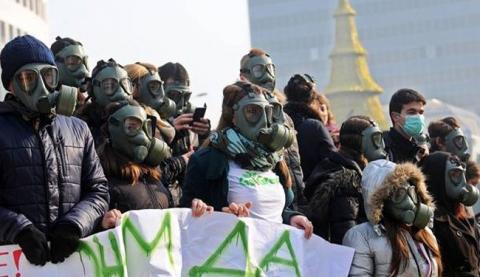Air pollution kills thousands every year
Ministers have been pressed to reduce traffic emissions after conclusive evidence that pollution within legal limits is dangerous. Yesterday the British Medical Association urged the government to install pollution monitors at the roadside and give councils the power to ban highly polluting vehicles from certain routes or at particular times of day. Researchers gathered data on almost every American over the age of 65, and compared their health over seven years with pollution levels accurate to the nearest square kilometre to give the most detailed picture possible of the effects of ultrafine particulate matter (PM2.5) on their risk of early death.
Such particles are emitted by car engines and power plants, and thrown up by brakes and road wear, and have been linked to breathing and circulation problems. In the EU, levels of PM2.5 below 25 micrograms per cubic metre of air are considered safe, while the US allows 12 micrograms/m³. However, scientists report in the New England Journal of Medicine that even below this lower limit, a rise of 10 micrograms/m³ increased the risk of dying during the study by 14 per cent. Francesca Dominici of the Harvard school of public health, the principal investigator in the project, said: “The key message of this study is that low-level pollution kills.”
She estimated that a 1 microgram/m³ reduction in PM2.5 would save 12,000 lives a year in the US, or 2,400 in Britain. “Ten micrograms is a big change, it corresponds to comparing the most polluted city in the US with the least polluted,” she said. “But 1 microgram is a very small change. No person could see a difference that small.” Professor Dominici urged lower limits to bring down emissions, saying: “If the FBI tells your government that you’re certain a jumbo jet is going to crash every 12 days unless you do something about it, you would pay attention. This is the level of confidence that we have, and people should pay attention.”
Jonathan Grigg, of Queen Mary University of London said: “We know what the answer is; if you reduce emissions today, exposure will reduce today. This is a very tractable problem, it just needs political will. “If we remove diesel cars and change . . . to less polluting vehicles you would certainly make a difference of more than 1 microgram per cubic metre.”
Naima Bradley, head of environmental hazards at Public Health England, said: “This research adds to the evidence that there is no level at which particulate air pollution is harmless, however in the UK we have air quality standards to minimise health effects.”
Behind the story Headlines have focused on nitrogen dioxide rather than PM2.5, but ultrafine particles are especially bad for health as they penetrate the lungs and other sensitive tissues. Yet legal limits are “ridiculously” high, according to Frank Kelly, professor of environmental health at King’s College London. The WHO recommended a cap of 10 micrograms/m³ in 2005, but the EU set its legal limit at 25 micrograms/m³ — influenced, Professor Kelly says, by eastern European nations fearing for their industry. “This is one reason why you don’t hear about PM2.5 in Europe,” he said.
Chris Smyth

